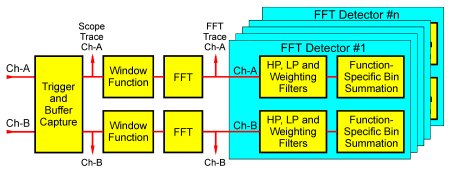dScope Series III Architecture Guide
FFT ANALYZER ARCHITECTURE
The figure above illustrates the functionality of the dScope's FFT Analyzer (FFTA).The FFTA operates by capturing a buffer of audio samples which are then processed to display the Scope and FFT Traces, and to calculate Results for up to 40 simultaneous FFT Detectors (FFTDs). Each FFTD can perform different measurements, with different filter settings if required. The FFTA can operate in two-channel mode, or in single-channel mode (which is faster) if required. A sample FFT Detector is shown below:

On entering the FFTA, the input signal is compared against the user-defined trigger condition. When the trigger condition is satisfied the FFT buffer is filled, with the trigger point located at the selected point in the buffer. Triggering can be continuous or threshold-activated, and can be repetitive or single-shot. A manual setting is also provided where sampling takes place when a key is pressed. The unprocessed buffer is used to display the Scope Trace, if enabled. The buffer is then windowed with the selected FFT Window function, and an FFT is calculated. The FFT data is used to display the FFT Trace, or spectrum, of the audio if enabled, and also to calculate any FFT Detectors which are active. The length of the buffer (and subsequent FFT) can be set between 1k and 256k points. The FFT data can also be successively averaged from a user-defined number of successively captured buffers if required; this allows noise to be reduced and small components to be distinguished in the FFT Trace.
Each FFT Detector may apply high-pass, low-pass and Weighting filters prior to bin summation. The selection of filters may be different for each FFT Detector if required, or all may use a common set of filters. Bin summation then produces the selected FFTD Result according to the summation mode selected. Note that all FFTD Results have an RMS response, owing to the nature of the FFT process.
The bin summation process essentially emulates the BP/BR function of the CTA. For wide-band measurements, all FFT bins are summed; for band pass (selective) measurements, only the bins in a narrow range of frequencies are included; for band reject (residual) measurements, such as THD+N, bins within a frequency range are excluded from the summation. The BP/BR frequency can be set to track the detected Analyzer frequency, or the Generator frequency, or it can be fixed at a preset frequency. A range of different BP/BR bandwidths (Q–factors) is provided in the same way as in the CTD, and in addition there is a 'window-width' mode where the BP/BR filter includes or removes ONLY the specified frequency, with essentially infinite Q, covering only the number of bins which may contain the specified frequency, as defined by the selected Window function. Bin summation Results can be displayed in absolute or relative modes. In relative mode, the Result is normally expressed relative to the pre-band-reject signal amplitude, as in the THD+N case. However, a number of other options for the relative-reference exist, for example the output of the Signal Generator (for gain measurements), or the Analyzer input of the opposite channel (for cross-talk measurements).
The versatility of the FFTD's bin summation process allows it to perform many measurements which the CTD cannot, for example THD can be measured without including noise by summing only the harmonics of the input frequency, or individual harmonic distortion (e.g. 3rd harmonic) can be measured. By writing a customised 'FFT Detector Calculation script', the user can generate his own FFTD Results by scripting the summation of the FFT (and/or input buffer) bins as he wishes. This facility offers a level of flexibility unrivalled in other instruments. The process is described in the FFT Detector Calculation scripts section of the Scripting Manual.
By using the Multi-tone Generation and Analysis dialogue box, it is possible to automatically create and script a large number of simultaneous FFT Detectors which will extract various Results from a synchronous multi-tone stimulus, which is scripted within the Signal Generator. The process of setting up a complete multi-tone test is highly automated. For generation this consists of selecting options from drop-lists such as sample rate, FFT buffer length, then defining the required number of tones, their frequencies and amplitudes. For analysis, it is much the same, with all the options presented in a clear and flexible manner. All the hard work of generating the multi-tone signal and setting up the analyzer to extract the information is automated.



